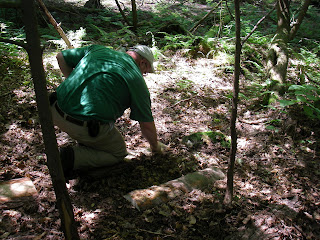 |
Red Eft life stage of a Red-spotted Newt in Catlin Woods
|
We experimented with one of the newly
assembled cover board sites by removing leaf litter underneath every other
cover board, exposing the bare, damp soil. When a piece of wood or any heavy
object is left on the forest ground, the leaf litter that it shields eventually
breaks up and decomposes, therefore becoming part of the soil. We wondered whether
by accelerating this process, so that only soil meets the cover board, the
salamanders would be more likely detected because there isn't any leaf debris
that can cover them. This observational experiment will help us see if there is
a noticeable pattern and tell us if we should develop an experiment with more
replicates. We will check the plot every couple of weeks noting if salamanders
were more often discovered under removed leaf debris cover boards. We need to
be especially thorough when checking the uncleared cover boards because
salamanders are more difficult to spot when there are layers of leaves that
they can hide in. By not counting all salamanders present, this may result in a
false correlation in our experiment.
 |
| James Fischer marking the cleared leaf debris cover boards. |

No comments:
Post a Comment